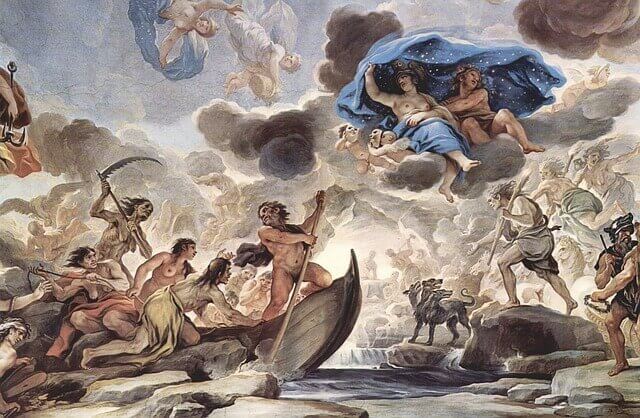Greek mythology or Greek myth refers to a collection of stories and fables about the adventures and lives of Greek gods, goddesses, heroes, monsters, and rituals of the ancient Greek civilization. Greek mythology has been known to influence how creative art forms, including modern art, are created and perceived.
From Greek renaissance paintings to Greek mythology paintings, conceptual and surrealist paintings, and drawings alike, you’re likely to see indications of Greek mythology in their subjects and props. Pablo Picasso, Barnett Newman, and Henri Pierre are a few artists who have depicted Greek myths.
This article will recount notable Greek myths and list the modern Greek mythology paintings they inspired.
What is Modern Art?
Modern art describes the artistic works produced between the late 19th century and the late 20th century. It represents the styles, techniques, and philosophies artists from those periods used, which challenged those before them.
Examples of Artists and their art that fall within this period include Warhol’s Campbell’s Soup Cans, Picasso’s Les Demoiselles d’Avignon, and Van Gogh’s Sunflowers. These are revolutionary works that are used in art studies today.
Greek Mythology and Modern Artworks
Now that we’ve defined modern art, which of these artists and their works were influenced by Greek mythology? In the following sections, we’ll discuss some examples of Greek mythology and the modern art they inspired.
- Achilles
- The Minotaur
- Perseus and Andromeda
Achilles (Achilles’ Heel)
Son of Peleus, the mortal king of Myrmidons, and Thetis, the sea Nymph, Achilles was one of the greatest warriors and heroes of ancient Greece. When he was still a child, his mother Thetis took him to the River Styx and dipped him in it, holding him by his heel.
It was here that he became invulnerable. His entire body became impenetrable to weapons and harm, except for the part his mother held him with, his heel.
Later, his father, Peleus, received a prophecy that Achilles would die in the great battle of Troy. So, in an attempt to save his son, he sent him to the court of Lycomedes on Scyros to be disguised as a girl among the king’s daughters.
In direct opposition to this action, the Greeks received another prophecy saying that they could not win the battle of Troy without Achilles. So they launched a search for him and found him. The war began, and Achilles took twelve cities surrounding Troy within the first nine years.
Battle after battle, he fought and won until the final battle at Troy, where the Trojan prince Paris shot an arrow at Achilles. It is said that the god Apollo guided Paris’ arrow to Achilles’ heel, his only weak spot. Hence, the inspiration for people’s weaknesses is called their Achilles Heel.
Modern Greek Mythology Paintings Inspired by Achilles
Some modern mythology paintings inspired by Achilles include the following:
- Achilles, 1952 by Barnett Newman
- Fifty Days at Iliam: Shades of Achilles, Patroclus, and Hector (1978) by Cy Twombly
The Minotaur
Minotaurs are half-beast, half-human creatures in Greek mythology. The first minotaur was born to King Minos and Queen Pasiphae of Crete. King Minos had his trusted inventor design and create a labyrinth where they held the minotaur to protect the people and hide the beast.
The minotaur made demands of a frequent offering of seven young virgins and seven young men. However, the frequency of these sacrifices is unknown due to the variance in several accounts of the story.
The Minotaur’s dominance and disturbance eventually ended when Theseus, the Greek hero, slayed the beast and the sacrifices ended. However, the stories and representations of this half-human creature live on in art.
Modern Greek Mythology Paintings Inspired by the Minotaur
Some mythology paintings inspired by the Minotaurs include the following:
- And Then We Saw the Daughter of the Minotaur! (1953) by Leonora Carrington
- Minotaure (1943) by Jackson Pollock
- Minotauromachy (1935) by Pablo Picasso
Perseus and Andromeda
Perseus is another hero and warrior in Greek mythology. His most memorable adventures are about how he slayed Medusa, the mortal Gorgon, and rescued Andromeda from a sea beast.
Perseus had gone on a quest to slay Medusa, who had a head of snakes for hair and could turn anyone who looked at her directly to the stone. Using a curved sword, the cap of Hades for invisibility, and sandals with wings for flying, Perseus attacked and beheaded Medusa.
Returning with his head, he met the Ethiopian princess Andromeda. Her father, King Cepheus, had put her out as a sacrifice to the sea dragon sent by Poseidon, god of the sea.
Her mother, Cassiopeia, had angered Poseidon by boasting that she was more beautiful than the Nereids or sea Nymphs. So, as punishment, Poseidon flooded Ethiopia and had a sea monster terrorize Ethiopia.
In search of a solution, King Cepheus received an oracle that advised him to sacrifice his daughter to the sea monster to end their suffering. So the king put her out, but it wasn’t because of this that the sea monster stopped his terrorism against Ethiopia.
Perseus saw Andromeda in danger at the rock her people tied her to and fell for her. He showed the sea beast Medusa’s head, turning it into stone, and saved the princess. He later married Andromeda.
Modern Greek Mythology Paintings inspired by Perseus and Andromeda
Some modern mythology paintings that portray or were inspired by Perseus and Andromeda are the following:
- Perseus’s Last Duty (1949) by Max Beckmann
- Perseus and Andromeda (1870) by Gustave Moreau
- Andromeda Chained to a Rock (1874) by Henri Pierre
To art enthusiasts, it’s no news that some of your favorite and prolific artists have been influenced by Greek mythology. Tales about Perseus and Andromeda, Achilles, and the half-human, half-beast Minotaur are only a few stories from Greek mythology that have inspired modern art.
Some of these artworks were for art study and entertainment, while some others were created as a reflection of the artist’s life and environmental circumstances. Artists who want to create masterful work should follow in the footsteps of modern masters by studying other cultures, such as Ancient Greece.
Conclusion
By looking at various pieces of artwork, it is possible to see the correlation between them and Greek mythology. These stories have been passed down for centuries and are still relevant in society today. It is easy to feel a connection to these myths, whether or not you are familiar with them. The next time you see a piece of modern art, take a moment to think about the story behind it and how it might be related to Greek mythology.
















